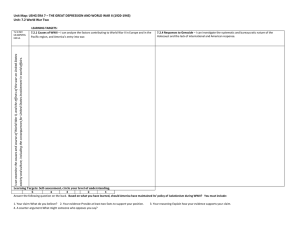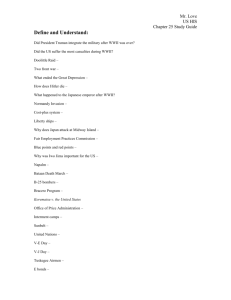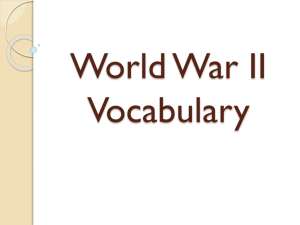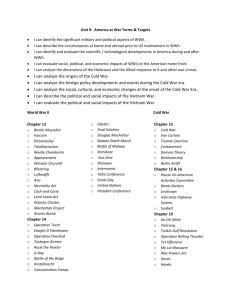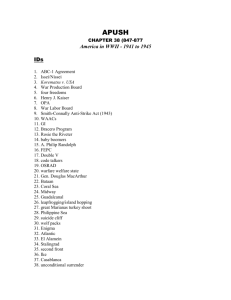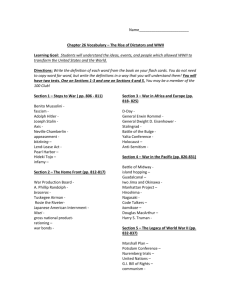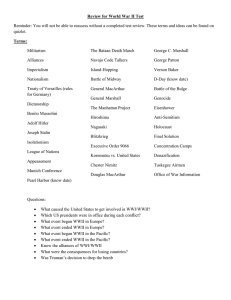Document 10995633
advertisement
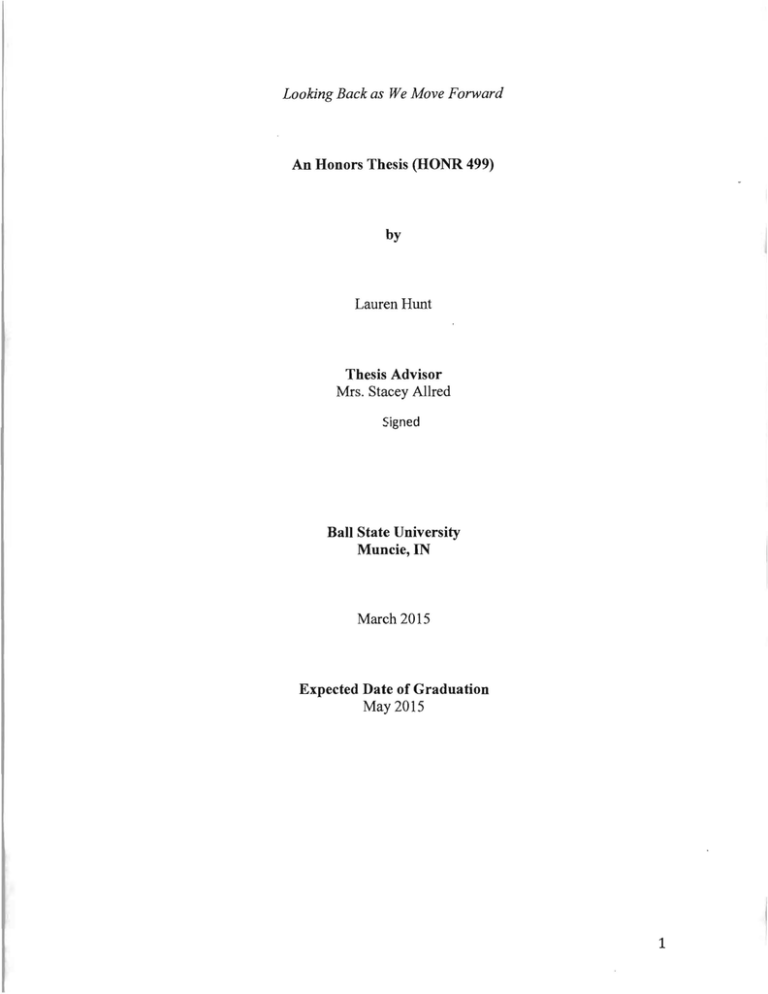
Looking Back as We Move Forward
An Honors Thesis (HONR 499)
by
Lauren Hunt
Thesis Advisor
Mrs. Stacey Allred
Signed
Ball State University Muncie, IN March 2015
Expected Date of Graduation
May 2015
1
Abstract
,H {
Personal journeys have been used to teach major historical events for years. People cling
to these stories because they can connect a real person to the event. The same is true of
children. They will retain knowledge much better if there is a personal connection made.
In this five-day unit, I use my own grandfather's WWII diary as a springboard for
exploring different perspectives and roles throughout that time period. The students will
discover various roles that men and women played in aiding the war effort and even
come to understand that there are always at least two sides to every story.
Acknowledgements
I would like to thank Mrs. Allred for all of her help throughout this project. She
constantly pushed me to give my future students the best lessons that I could. This thesis
is only one example of the many ways she has helped and inspired me throughout my
college career. Mrs. Allred is truly an example of an amazing teacher.
2
Author' s Statement
This unit/thesis project actually started to fonn my sophomore year at Ball State
University. During the spring semester, I enrolled in Honors 199 with Dr. Edmonds. I
heard marvelous things about him as a professor, and I was not disappointed. The course
surrounded a study of families and is still to date one of my favorite classes I have ever
taken.
One of the first assignments of the semester was to bring in something from our
family that held value to us. It could be an item or a picture of an item. I brought in my
grandfather' s journal he kept during WWII. He kept it hidden on the ship and it was
never discovered even though he wrote in it almost daily. My grandfather died when I
was very young, so reading this helped me get to know him better. I also have also
enjoyed studying about WWII, so this was a perfect piece for me to use. After my
presentation, Dr. Edmonds pulled me aside and told me I should think about getting the
diary published and doing something with it for my senior honors thesis. He put me in
touch with a couple of history professors, and I started working from there.
The history professors were both very nice and had great ideas, however they
wanted me to go more in a direction of creating narration to go along with the diary and
publishing it. I did not have any prior experience with either of those processes, so we
ultimately decided it would be a better idea if I incorporated the diary in a different way
for my honors thesis.
I based my idea for a unit plan off of a prior idea I had discussed with one of the
history professors. I thOUght making a unit incorporating something so personal to me
would be a great way to teach future students. Students are more likely to remember
3
infonnation if you make it personal to their lives, and what better way to model that than
to create something that is so personal to me?
When starting my unit plan, I had to first look at the state standards. I knew
fmding standards to match this topic would be challenging because students do not study
WWII in Social Studies in elementary school. However, as I discovered when
researching the standards, students do learn about how Indiana citizens affected WWII.
It was through these and other Reading and Writing standards that I was able to
incorporate the diary into this unit.
I decided I wanted the unit to incorporate different perspectives and roles that
Indiana citizens had during this time period. I decided to do a simple five day unit
because that gives me a plan for each day of the school week, and I can always extend
lessons over a few days if the students need more time to accomplish the objective and
gain the knowledge from a particular lesson. After deciding how long I wanted the unit to
be, the next step was to begin to plan each day's objective. Again, I referred to the
standards I picked before starting any planning. I knew I wanted to move from the
students examining infonnation to creating infonnation, so my first lesson plan has the
students differentiating between a primary and secondary source. This is an important
distinction, especially when studying history. The second day, I wanted to contrast the
roles the students read about during day one, so they are reading and writing about
women and the roles they had during WWII. I hoped the students would start to
understand that everyone had an important role during the war, and that the soldiers could
not have effectively done their job if the people, especially the women, back home had
not done theirs. After researching various ways people helped during the war, I thought it
4
was important for students to have a real life example. As stated before, students tend to
remember information better when it is made personal to them. Therefore, day three's
lesson revolves around interviewing a veteran. The students are guided through writing
strong interview questions and are cautioned that veterans do not always want to share
everything about their experiences. Hearing a veteran's personal perspective should help
students make connections to what they have read the past two days.
The next two days' plans move into the students creating. Day four focuses on
the different perspectives during the war, including German and English perspectives. I
thought it was important that the students learn that there are always multiple
perspectives to every major event in history. During this lesson, they will read and watch
different perspectives and then fill out a graphic organizer identifying similarities and
differences. I chose a double bubble map because I personally am not a fan of the Venn
diagram. I prefer to use this graphic organizer, which serves the same purpose. Graphic
organizers help students organize their thoughts and are a great tool for students of all
ability levels. After they complete the organizer, they will write about the similarities
and differences using a standard outline format. This will help students practice finding
support for their main topics and overall enhance their writing abilities. The last day of
this unit requires the students to see an event from a different perspective when they write
a diary entry as if they are German, Japanese, or British. I chose this as the final day of
the unit because I thought that it really brought the unit full circle, as it starts with an
activity utilizing my grandfather' S diary. Writing from a different perspective not only
helps students with their writing abilities but also their critical thinking skills. Putting
yourself in someone else ' s shoes is a skill that children need to be taught and has very
5
real world applications. This activity is meant to not only help them academically, but
also in their lives after they leave my classroom.
This unit plan is very personal to me, and I am very proud of it. I made the
decisions for the items included in it based on my own teaching philosophy and what I
think will help students succeed in the classroom and beyond. On the next page, I have
provided an explanation for each aspect of a lesson plan to aid the reader with
understanding the unit plan.
6
Day One 7
Name: Lauren Hunt Supervising Professor: Mrs. Allred
Due Date: May 2,2014 Teach Date: October 1,2015
Subject: Social StudieslLanguage Arts
Grade Level: 4th
Lesson Topic: Primary and Secondary Sources
Unit Objective: Students will analyze (analyze) roles Indiana citizens had in WWII.
INT ASC Principle #1 - Understand Content:
The Professional educator understands the central concepts, tolls of inquiry, and
structures of the discipline(s) he or she teaches and can create learning experiences that
make these aspects of subject matter meaningful for students.
INT ASC Principle #7 - Plans and Integrates
The professional educator plans instruction based on knowledge of subject matter, the
community, and the curriculum goals.
IN State Standard(s) and State Indicator(s):
LA.4.RN.3.3 Compare and contrast a firsthand and secondhand account of the same
event or topic; describe the differences in focus and the information provided in the
accounts.
Lesson Objective: The student will compare and contrast primary and secondary
sources. (Analysis)
MaterialslMedia:
• Diary excerpt (pgs. 50-51)
• Story from http://www.pbs.orglwgbhlarnexldday/sfeature/sCvoices_02.htmlAllen W. Stephens
• Video from http://www.history.comltopics/world-war-ii/d-day
• Graphic Organizers - Venn Diagram
• Pictures of D-Day
Motivation: The teacher will show different pictures from D-Day. Some will be pictures
taken by her grandfather, and some will be from other sources. The teacher will ask the
students to predict what they think the photos are from and react to the pictures.
Goal for Learner: Today, we are going to learn about the difference between a primary
and secondary source.
Procedure:
• New Information
o Primary source - any record made by people who took part in an event or
saw it happen
8
•
•
•
•
•
o Secondary source - a record made by people who did not take part in an
event or did not see it take place
o D-Day
• June 6, 1944
• More than 160,000 troops from the Allies side of the war invaded
the beaches of Normandy, France. More than 5,000 ships and
13,000 aircrafts helped with the invasion. My grandfather was on
one of those ships, and we will be using his diary as a primary
source to gain knowledge of what took place. There were over
9,000 Allied soldiers who were killed or injured, but this victory
allowed the Allies to start moving across Europe, defeating the
Nazis as they went.
Modeling
o Teacher will utilize strategy of "thinking aloud" and use prior information
to complete the organizer.
o Primary Source - author witnessed event, one perspective
o Secondary Source - author did not witness event, multiple perspectives
o Both - About one event
Check for Understanding
o The teacher will ask questions in order to check the students'
understanding.
o What is a primary source? (Knowledge) What are some examples of a
primary source? (Application) What is a secondary source? (Knowledge)
What are some examples of a secondary source? (Application) What is
the difference between a primary and secondary source? (Analysis)
Which would you prefer to have? Why? (Synthesis)
Guided Practice
o The teacher will read excerpts from a primary source and watch a second
hand account of D-Day.
o Primary source (Allen W. Stephens) will already be filled out with details
of the event and the perspective of the account.
o Together students and teacher will fill out a graphic organizer for the
secondary account (video at http://www.history.comltopics/world-war­
ii/d-day) with the details of the event and perspective of the account.
Check for Understanding
o The teacher will ask "What are the differences between the primary and
secondary accounts?" (Analysis) "What are some advantages to using a
primary source?" "What are some disadvantages to using a primary
source?" (Analysis) "When would you use a secondary source?"
(Evaluation)
Practice/Application
o Students will read excerpt from the diary and a second hand account of D­
Day. They will fill out a graphic organizer for the primary account to
include details of the event and perspective.
9
o Primary account - pgs. 50-51 from diary of Leon Hunt
o Secondary account - article at http://www.history.comltopics/world-war­
ii/d-day
• The details of the event and the perspective of the account will
already be filled out on the organizer.
• Accommodations
o High Ability - Find another secondary source and use a Venn diagram to
compare and contrast it with the secondary source they already have.
o Remedial- Students will be provided with entries that have important
facts highlighted.
• Closure
o The teacher will ask the students "What is the difference between a
primary source and a secondary source?" (Analysis) "Why is it important
to look at multiple perspectives?" (Synthesis) "How can primary and
secondary sources help us understand events that happened?"
(Evaluation) "What are some events you think you or your parents could
tell primary accounts of?" (Application)
• Evaluation
o The teacher will collect the graphic organizers and evaluate them.
LA.4.RN.3.3
Compare and
contrast a firsthand
and secondhand
account of the same
event or topic;
describe the
differences in focus
and the information
provided in the
accounts.
LA.4.RN.3.3
Compare and
contrast a firsthand
and secondhand
account of the same
event or topic;
describe the
differences in focus
and the information
provided in the
accounts.
Needs Help
Student provides
one detail of the
event.
Emerging
Student provides at
least two detail of
the event.
Mastery
Student provides at
least three details of
the event.
Student does not
identify a
perspective for the
account.
Student identifies
the wrong
perspective of the
account.
Student identifies
the correct
perspective of the
account.
10
Extension: Students will create a firsthand account of an event that they have witnessed.
11
Diary Entry (pgs. 50 - 51)
June 7 -Underway for Plymouth, England with 60 casualties. Army and
Navy aboard from beach landing in France. Dropping hook in harbor at
Portland, England, at 1100. Moving into docks at 1230. Unloaded
wounded into waiting ambulances on docks. Taking on fresh water and
supplies for Army. Loading up with armored division, tanks, big guns,
half tracks, armored trucks, etc. Pulling away from docks at 2300.
Tying up to buoy in harbor.
June 8 - At buoy in harbor, Portland, England. Loaded with armored
division. News at midnight reported more than 6000 ships took part in
the landing in France and Allied air craft flew 2400 sorties over beach
during the first day's operations. Army was 8 to 10 miles inland now
but expect the greatest sea, air, and land battles yet to come. Sounds
interesting. Underway for the invasion beach of France at 1600.
June 9 - Underway for France. General quarters called at 0320. German
E boasts attacked our convoy of 5 LST's. They sank two out of the five.
As far as we know, there were no survivors. Both fully loaded with
Army and equipment. Of the original flotilla of 8 LST's, of which we
have been flagship since leaving the sates, only 3 are still floating. The
315,316,317. Pulling into harbor near invasion beach at 0530.
Dropped anchor. Unloading Army and equipment at 1000 by Rhino.
Took aboard 11 casualties at 1100. Survivors of a British merchant ship
which was hit by a bomb, came aboard at 1300. Also survivors from 2
American patrol craft which hit mines and sank. They are scuttling
several British and American merchant ships to form a breakwater
12
around beach. Enemy planes overhead at 0910. General quarters
called. Secured at 0930. Eight enemy planes shot down. Also 2 of ours.
June 10 - At anchor near invasion beach. Underway at 0330. Going into
beach or close by to pick up wounded. We have four doctors and 4
operating tables aboard now. Also about 35 hospital corpsmen.
Anchored at 0420. 93 wounded soldiers came aboard at 1210. Most of
them are paratroopers and badly shot up. Guess we are going to serve
as auxiliary hospital evacuation ship. Radio reports Army is 29 miles
inland and meeting fierce resistance. Also that the port of Cherbourg
has been taken by Allied forces. The paratroopers have reported that
the Germans are using French women as shields and are forcing them at
point of guns to shoot at advancing Army. Guess it is really bad. Four of
the wounded aboard here are Germans. All of them really shot up. They
say that Hitler has told them that Allies had no equipment but they
never saw so much equipment in their lives as that which has landed on
beach the past 4 days. Underway for Portland, England, at 2245.
June 11 - Underway for Portland, England. Standing in port at 1000.
Tied up to dock at 1030. Unloading casualties into waiting ambulances.
Pulling out into harbor at 1150. Tied up to buoy at 1230. News reports
Allies still advancin
June 12 - Tied up to buoy in harbor, Portland, England. Loading up with
big guns (field artillery) and U.S. infantry at 2000. Pulling out and
anchored at 2310.
June 13 - At anchor, Portland, England. Loaded. Underway at 0400 for
beachhead in France. Sailing on 13th, 13 ships in convoy, and 2 black
cats aboard. So what? One ship had engine trouble, dropped back of
13
convoy. Pulling into beachhead area at 1830. We are going to beach
this time. going into beach at 2000. There is a tremendous tide here at
the beach.
14
Day Two 15
Name: Lauren Hunt
Supervising Professor: Mrs. Allred
Due Date: May 2, 2014
Teach Date: October 1,2015
Subject: Social Studies
Grade Level:
4th
Lesson Topic: Women in WWII
Unit Objective: Students will analyze (analyze) roles Indiana citizens had in WWII.
INTASC Principle #1 - Understand Content: The Professional educator understands the central concepts, tolls of inquiry, and structures of the discipline(s) he or she teaches and can create learning experiences that make these aspects of subject matter meaningful for students. INT ASC Principle #7 - Plans and Integrates The professional educator plans instruction based on knowledge of subject matter, the community, and the curriculum goals. IN State Standard(s) and State Indicator(s): SS.4.1.10 Describe the participation oflndiana citizens in World War I and World War II.
Lesson Objective: Students will determine jobs women had during WWII and how this
contributed to the war effort. (Analysis)
MaterialslMedia:
• Posters/pictures of posters of women from WWII from Google image search
• Interview with Grandmother
• Stories from women from Internet sites listed throughout lesson
• Paper
• Pencils
Motivation: The teacher will show posters from WWII that depict women doing
different jobs. The teacher will ask the class to make predictions about what the women
are doing and why they are doing it.
Goal for Learner: Yesterday, we learned about the things a lot of men did during the
war. Today, we are going to learn about jobs that women had during WWII.
Procedure:
• New Information
o This will be presented through a PowerPoint, including pictures.
o While men were off at war, many women had to take over their jobs.
16
o The percentage of women in the workforce increased from 27% to 37%
between 1940-1945. At the end of the war, one out of every four married
women worked outside the home.
o Rosie the Riveter was a pivotal figure in drawing women to the workforce.
She was used in propaganda campaigns to recruit women workers to the
workforce, especially the munitions workforce.
o Women made a lot of the supplies, equipment that their men used in the
war.
o The aviation industry had the greatest increase in the amount of workers.
65% of the aviation workforce in 1943 was made up of women. It had
only been 1% before the war.
o Women also worked outside of the factories. Some even joined the armed
forces themselves. 200,000 women joined the armed forces but were kept
from combat. Many became nurses to help injured soldiers.
o Another 3 million volunteered for the Red Cross.
o Women played a pivotal role in the war effort, but almost all were laid off
when the men returned home from war.
• Modeling
o The teacher will share an interview with her grandmother about her
experience as a wife of a deployed soldier.
o She will think aloud as she writes down some of the things her
grandmother did and shared.
o For example, her grandmother now had to provide for herself. She got a
teaching job, but had to sign a contract that if her husband came back from
the war, she would give up her job.
• Check for Understanding
o "What were some jobs that women had during WWII?" (Knowledge)
"Why did the female workforce increase so much during WWII?"
(Comprehension) "Who was the character that was the face of
propaganda for women joining the workforce?" (Knowledge) "Why did
women lose their jobs when the men came back?" (Comprehension)
"What job do you think you would have had if you were a woman during
WWlI?" (Application) "Why were women allowed to have jobs but not
allowed to fight?" (Analyze) "Is this different than today?" (Analyze)
• Guided Practice
o The teacher will distribute a copy of the article from http://www.striking­
women.orglmodule/women-and-worklworld-war-ii-1939-1945 to each
student in the class.
o The teacher will randomly call on students to read aloud from the article.
o As we read, we will make a class list ofjobs that women had during the
war, looking up any jobs that we are not familiar with.
o Then, the class will be split up into groups of four. Each group will get 5
- 10 minutes to discuss the questions "Would men have been as successful
during the war without the contribution of women? Why or why not?"
17
o After the 5 - 10 minutes, each group will share out with the whole class,
and we will decide as a class if we think men would have been as
successful without the women.
• Accommodation
o Remedial- Students will have a copy of the story with jobs highlighted.
• Check for Understanding
o "Why was it important that this woman was in the armed forces?" "Why
should we thank her if she did not ever see battle?"
• Practice/Application
o The students will be given several site addresses to visit that contain
stories of women in WWII.
• http://lcweb2.loc.gov/diglib/vhp­
stories/loc.natlib.afc2001001.042931 • http://www.familysecuritymatters.org/publications/detail/wwii­
female-pilot -tell s-exhilarating -secret -stories-of-wartime-expl oi ts
o They will visit these pages and choose a woman's story to read.
o As they read, they will take notes on her background, her role before the
war, how her life changed and her contribution during the war, and her
role after the war.
o They will then write a short response to the prompt "How do you define a
hero? Do you think the woman you read about is a hero? Why or why
not?" Provide at least three reasons." (Analyze)
• Accommodation
o High Ability - Students will research how many women are now in the
anned forces and the roles they have in the anned forces. Compare that to
the number of women in the anned forces during WWII. Brainstonn what
Indiana citizens could do to help those in the anned forces currently.
• Closure
o The teacher will ask the students, "What are some different roles that
women had in WWII?" "Why did so many women join the workforce
during WWII?" "What job do you think you would've had in WWII?"
"Would we see the same thing happen if a war were to break out today?"
"Why or why not?" (Evaluation)
• Evaluation
Needs Help
Emerging
Mastery
SSA.1.lO Describe
Student did not
Student defined a
Student defined a
the participation of
define a hero or
hero OR stated that
hero and stated that
Indiana citizens in
state that the woman the woman was or
the woman was or
was or was not a
was not a hero.
World War I and
was not a hero.
World War II.
hero.
SSA.1.lO Describe
the participation of
Indiana citizens in
World War I and
World War II.
Student included
less than two
reasons why or why
not the woman was
a hero.
Student included
two reasons why or
why not the woman
was a hero.
Student included at
least three reasons
why or why not the
woman was a hero.
18
• Extension: Students will write a letter to one of the women they have read about
thanking her for her service. They should include at least two details about her
life that they found interesting or inspiring. They should also include at least two
details about themselves so that the woman can know about them.
19
Day Three 20
Name: Lauren Hunt
Supervising Professor: Mrs. Allred
Due Date: May 2, 2014
Teach Date: October 1,2015
Subject: Social Studies
Grade Level:
4th
Lesson Topic: A Veteran's Perspective
Unit Objective: Students will analyze (analyze) roles Indiana citizens had in WWII.
INTASC Principle #1- Understand Content: The Professional educator understands the central concepts, tolls of inquiry, and structures of the discipline(s) he or she teaches and can create learning experiences that make these aspects of subject matter meaningful for students. INTASC Principle #7 - Plans and Integrates The professional educator plans instruction based on knowledge of subject matter, the community, and the curriculum goals. IN State Standard(s) and State Indicator(s): 4.SL.2.4 Pose and respond to specific questions to clarify or follow up on information, and make comments that contribute to the discussion and link to the remarks of others. Lesson Objective: Students will discover what life was like while serving during WWII. (Apply) MaterialslMedia:
•
•
•
•
Veteran from the community
Video from https://www.youtube.com!watch?v=hJ-uoJHY4Lk
Paper
Pencils
Motivation: The teacher will show them a clip of an interview with Carrie Underwood
on Ellen. The teacher will ask them what types of questions Ellen asked and what they
noticed about the interview in general. (Types of questions: who, what, when, where,
why, how)
Goal for Learner: We have been learning about the different jobs that people did in
WWII. Today, we are going to hear a personal account from a veteran. We will be
interviewing him and discovering what life was like for him. Just like we saw Ellen ask
Carrie questions, we are going to be asking him questions. However, it is going to be
more serious. A lot of veterans are not comfortable talking about certain parts of their
time that they served, so ifhe says he doesn't want to answer a question, we will move
on.
21
Procedure:
• New Information
o Interviewing someone is a good way to learn about them and experiences
that you have not experienced firsthand. This can help you discover what
it was like for other people and connect with them.
o When you interview someone, you need to cover six major questions:
who, what, where, when, why, and how.
o Once you have these questions, you should develop a few follow up
questions to continue the interview.
o Always allow time for the person you are interviewing to answer before
you move onto the next question.
• Modeling
o The teacher will project a blank piece of paper onto the overhead.
o She will tell the students that she is going to think of questions that she
would ask Carrie Underwood if she were interviewing her.
o She will come up with one question for each of the six areas:
• Who has been your biggest inspiration throughout your career?
• What was your favorite song to record?
• Where is the most exciting place you have visited?
• When are you going to put out your next album?
• Why have you chosen to live in Nashville?
• How do you decide what to write and sing about?
o Next, the teacher will develop two follow up questions:
• "Where is the most exciting place you have visited?" Why?
• "How do you decide what to write and sing about? Do you use
your own experiences?
o The teacher will think aloud during this modeling. "These questions will
help me discover different parts of her life that I have not experienced."
• Check for Understanding
o The teacher will ask questions in order to check for understanding.
o "What are the six questions we always ask?" (Knowledge) "What are
follow up questions?" (Knowledge) "Why would we interview
someone?" (Comprehension)
• Guided Practice
o The teacher will divide the students into groups.
o Each group will discuss and write down at least two questions they have
for the veteran.
o As the groups are forming questions, the teacher will walk around and
monitorihelp.
o Each group will share their questions with the class.
o The teacher will make a master list of about ten questions.
• Accommodation
o Remedial - Students will have question prompts that they can fill in for
their questions.
• Practice
o Each student will write down at least three questions to ask the veteran.
22
o At least two of their questions cannot come from the master list.
o During the question and interview session, each student will have the
opportunity to ask one of their questions.
o Once everyone has had the opportunity to ask a question if they want to,
students can ask another question.
o After the veteran leaves, each student will either write or illustrate what
they think it was like to live through this experience.
• Accommodation
o High Ability - Students will illustrate what they think life was like for a
child during WWII.
• Closure
o "Today, we learned how to write interview questions, and we had the
opportunity to interview a veteran. We got to learn a lot about his life and
think about what it would be like to live his life. The nation's leaders
think that it is important to honor veterans who have served, which is why
we celebrate Veteran's Day every year." "Why is it important to talk to
people who lived through things like a war?" (Evaluation) "Would his
account be considered a primary or secondary source?" "Why?"
(Comprehension) "Who else could we interview to get a different
perspective of the war?" (Application)
• Evaluation
4.SL.2.4 Pose and
respond to specific
questions to clarify
or follow up on
information, and
make comments that
contribute to the
discussion and link
to the remarks of
others.
4.SL.2.4 Pose and
respond to specific
questions to clarify
or follow up on
information, and
make comments that
contribute to the
discussion and link
to the remarks of
others.
Needs Help
Student writes one
interview question.
Emerging
Student writes two
interview questions.
Mastery
Student writes at
least three interview
questions.
All of the interview
questions were on
the master list.
At least one of the
interview questions
is not on the master
list.
At least two of the
interview questions
are not on the
master list.
23
Extension: Students will write a journal entry as if they were living during WWII. Men
would (most likely) be fighting, and women would be working on the homefront.
24
Day Four 25
Name: Lauren Hunt Supervising Professor: Mrs. Allred
Due Date: May 2, 2014 Teach Date: October 1, 2015
Subject: Reading/Writing Grade Level: 4th
Lesson Topic: Different Views
Unit Objective: Students will analyze (analyze) roles Indiana citizens had in WWII.
INTASC Principle #1 - Understand Content: The Professional educator understands the central concepts, tolls of inquiry, and structures of the discipline(s) he or she teaches and can create learning experiences that make these aspects of subject matter meaningful for students. INTASC Principle #7 - Plans and Integrates The professional educator plans instruction based on knowledge of subject matter, the community, and the curriculum goals. IN State Standard(s) and State Indicator(s): 4.RNA.2 Combine information from two texts on the same topic in order to demonstrate knowledge about the subject. 4.W.3.2 Write informative compositions on a variety of topics.
Lesson Objective: Students will write (create) about different perspectives during
WWII.
MaterialslMedia:
• Video from https:llwww.awesomestories.comlassetiviewlNormandy-Invasion-DDay _Footage-from -German _Perspecti ve
• Article from http://www.Ijgeib.com/heroes/draper/german-point-of-view.html
• Article from http://www.bbc.comlnews/magazine-27730193
• Article from http://www.eyewitnesstohistory.comldday.htm
• Article from
http://homepage.ntlworld.comlandrew.etheringtonlarticles/levell/dday_germany
erspective.htm
• Paper
• Pencils
Motivation: The teacher will bring in a box that has different wrapping paper on each
side. The box will be placed in the center of the students' desks so that every student is
able to see at least one side. She will ask students to describe what they are seeing. She
will call on students at random to describe the side that they can see. Depending on
where students are sitting, they should describe different patterns of wrapping paper. The
teacher will ask, "Did everyone see the same thing?" (Knowledge) "Why not?" (Analyze)
26
After students answer the teacher will explain that each student saw something different
because everyone had a different perspective of the box.
Goal for Learner: Today, we are going to revisit D-Day from a different perspective.
We will read about what it was like for Germans and write about the similarities and
differences between the two sides.
Procedure:
• New Information
o The new information will be different based on the account the student
chooses to read .
o There is a first person account from a German soldier who became a
prisoner of war, a video from a third person perspective, a third person
account of a different German soldier, a first person perspective from a
German civilian, and a third person perspective that does not follow any
specific soldier.
• Modeling
o The teacher will project a double bubble map onto the overhead screen.
She will use the diary entry from Leon Hunt that the students have worked
with earlier in the week to fill out the left side of the organizer. Leon's
name will be placed in the middle. The surrounding circles will be filled
with facts from that day, such as specific times and number of ships, as
Leon writes about them along with feelings he expressed in the entry.
• Check for Understanding
o The teacher will use questioning to check for understanding.
o "Did I write things that are not mentioned in the entry?" (Knowledge)
"Why?" (Analyze) "What can you look for when you read an account?"
(Apply)
• Guided Practice
o The class will watch the video listed in the materials/media section.
o With help and suggestions from the class, the teacher will tIll out the other
side and the middle of the double bubble map.
o Then, the students will help the teacher outline how they could write about
these similarities and differences.
• Ex: Introduction, Similarities, Differences, Conclusion
• Accommodation
o Remedial- Students will be given a partially completed outline with a
word bank to choose from.
• Practice
o Students will use the excerpt from Leon Hunt's diary that was given to
them earlier in the week.
o They will choose one of the articles listed above in the materials/media
section.
o Then, the students will fill out a double bubble map comparing Leon
Hunt's entry with the account they choose.
27
o After filling out the map, they will write a composition comparing the two
accounts, using one of the outlines discussed earlier in class.
• Check for Understanding
o "What does each paragraph need to have?" (Comprehension) "Where can
we find details to elaborate on our statements?" (Comprehension) "About
how long should your paragraphs be?" (Knowledge) "What do we do at
the start of each paragraph?" (Knowledge)
• Accommodation
o High Ability - Students will use the double bubble map to compare and
then write about two of the German perspectives.
• Closure
o Today, we looked at a different perspective of D-Day. Every story has at
least two sides. For example, when something happens on the playground
between two of you, I listen to both sides of the story, or both
perspectives. This is true for major events, like D-Day. There will always
be multiple perspectives. "How can looking at multiple perspectives help
us understand events and history better?" (Apply) "Can you think of any
major events that have happened in your life that you think have multiple
perspectives?" (Apply) "If there are multiple perspectives, does that mean
that one side is completely right and the other is completely wrong?"
(Analyze) "Why?" (Why)
• Evaluation
Needs Help
Emer:gin~
MasteIY
Student compared
4.RN.4.2 Combine
Student did not
Student compared
Leon
Hunt's entry
information from
compare Leon
Leon Hunt's entry
with a German
two texts on the
Hunt's entry with a with a German
account
and filled
same topic in order
account but did not
German
out all bubbles on
to demonstrate
fill out all bubbles
perspective.
the
map.
knowledge about
on the map.
the subject.
4.W.3.2 Write
informative
compositions on a
variety of topics.
•
Student did not use
an appropriate
outline OR did not
include similarities
and differences or
supporting details.
Student used an
appropriate
outline, included
similarities and
differences, but did
not include
supporting details.
Student used an
appropriate
outline, included
similarities and
differences as well
as supporting
details.
Extension: Students will locate Normandy on a map and explore the beach today
using Google Maps.
28
Example of a Double Bubble Map
29 Day Five 30
Name: Lauren Hunt
Supervising Professor: Mrs. Allred
Due Date: May 2, 2014
Teach Date: October I, 20 IS
Subject: Reading/Writing
Grade Level:
4th
Lesson Topic: Research
Unit Objective: Students will analyze (analyze) roles Indiana citizens had in WWII.
INTASC Principle #1 - Understand Content: The Professional educator understands the central concepts, tolls of inquiry, and structures of the discipline(s) he or she teaches and can create learning experiences that make these aspects of subject matter meaningful for students. INTASC Principle #7 - Plans and Integrates The professional educator plans instruction based on knowledge of subject matter, the community, and the curriculum goals. IN State Standard(s) and State Indicator(s):
4.W.S Conduct short research on a topic.
Lesson Objective: Students will compose (create) a diary entry.
MaterialslMedia:
• Paper
• Pencil
• Article from http://www.bbc.comlnews/magazine-27730193
• Sources will differ based on individual student research
• Perspective picture (included at the end of the lesson)
Motivation: The teacher will split the class into groups. Each group will receive a copy
of the picture. The students will be instructed to look at and discuss the picture. After a
few minutes, the students will share out what they saw in the picture. Students should
have different answers because most of the time people see different things. The teacher
will ask why students had different answers. It should lead to the discussion that people
have different perspectives. The teacher will refer back to the lesson from yesterday.
Goal for Learner: Yesterday, we looked at different perspectives of D-Day. We learned
that there are many different perspectives for any situation. Today, you will research one
perspective and then write from that perspective.
Procedure:
• New Information
o This will depend upon which perspective each student chooses.
o Writing a diary entry is writing from a first person perspective.
31
•
•
•
•
o You will need to use "I, my, mine, etc." throughout the entry.
Modeling
o The teacher will read The True Story ofthe Three Little Pigs. After, she
will explain that this is from the wolfs perspective. She will point out the
differences in the story from the original Three Little Pigs. For example,
the wolf claims he was just trying to borrow some sugar. He also claims
that he had a cold, and that's why he was huffing and puffing - he was
actually sneezing.
o Then, the teacher will write out a diary entry from the wolfs perspective
as an example for the class. She will point out the use of "I, my, mine"
because it is a first person perspective.
Check for Understanding
o The teacher will use questioning to check for understanding.
o "Why do we need to use words like "I, my, and mine"?" (Comprehension)
"In my entry, did I use details from the story?" (Knowledge) "Why?"
(Apply) "Did the wolf talk about how he was feeling?" (Knowledge)
"Why would we talk about how we're feeling in a diary entry?" (Apply)
Guided Practice
o The teacher will bring up the article from
http://www.bbc.comlnews/magazine-27730193 that some of the students
used yesterday.
o Students will volunteer or be chosen to read and the class will do some
choral reading.
o The students will then think, pair, share. They will think of ideas,
sentences, concepts that should be included in the diary entry. Then, they
will pair up with an elbow buddy and share their ideas. Next, they will
share with the class.
o The teacher and the students will write down all ofthe ideas that are
shared.
o The students will have ten minutes to start fonning a diary entry based on
the ideas written down.
o The teacher will walk around to monitor and guide the students as they are
working.
o After the ten minutes, the teacher will choose a student example to share
with the class. The teacher will highlight the student's use of "I, my,
mine", details from the account, and feelings that were included.
Practice
o Students will research a different perspective of WWII. They can choose
between
• Gennan
• Japanese
• British
o They will research a major event during the war from the perspective that
they choose and then write a diary entry from that perspective. For
example, a student might write a diary entry about Pearl Harbor from the
Japanese perspective.
32
• Accommodations
o Remedial- Students will be given sentence starters/prompts and
questions they should research for their perspective.
o High Ability - Students will create a character profile for the perspective
they are writing from. They need to include the name, job, family, and a
picture of their character.
• Closure
o Today, we explored more perspectives of WWII. "Did anyone learn
something new today?" (Knowledge) "What did you learn?" (Knowledge)
"Did this change how you viewed that side/that event?" (Apply) It is
important to look at these different perspectives so we get a full view of
what happened. After we have a full view, then we can determine which
side we agree with. "Just because we agree with one side, does that mean
it is right?" (Analyze) No, often times there is not a black/white
right/wrong answer. People are divided over many issues, but it is
important to know what you believe and have reasons for it.
• Evaluation
Needs Help
Emerging
Mastery
4.W.5 Conduct
Student did not
Student chose one
Student chose one
short research on a
choose one
perspective OR one perspective and one
topic.
perspective or one
event.
event.
event.
4.W.5 Conduct
Student did not
Student wrote from
Student wrote from
short research on a
write from a first
a first person
a first person
person perspective.
perspective
topic.
perspective
throughout most of
throughout the
the entry.
entire entry
4.W.5 Conduct
Student did not
Student included
Student included
short research on a
include how he/she
one sentence about
more than two
topic.
feels.
how he/she feels.
sentences about how
he/she feels.
•
Extension: Students will post their entry in a blog space. Students can read and
respond to each other's entries.
33
